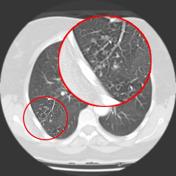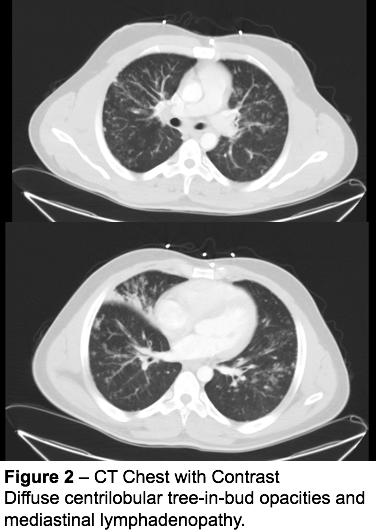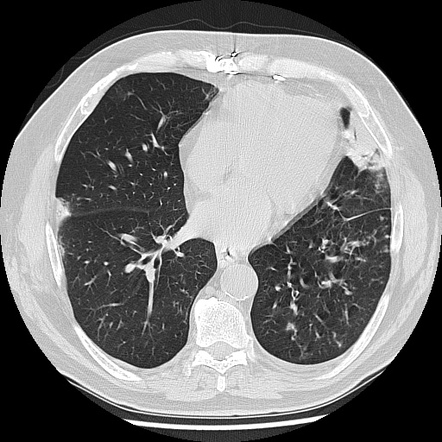tree in bud opacities causes
Bronchiectasis which may be of any cause can produce the tree-in-bud pattern. The purpose of this study was to determine the relative frequency of causes of tib opacities and identify patterns of disease associated with tib opacities.
The only noninflammatory cause of TIB opacities in our study was lymphoma which has previously been reported.

. Causes for TIB opacities were established in 166 of 406 409 cases. Tree-in-bud TIB opacities are a common imaging finding on thoracic CT scan. What causes tree-in-bud opacities.
Aspiration was the causein 42 of 166 25. Malignancy can be associated with the tree-in-bud sign. The classic cause of the tree-in-bud pattern is postprimary tuberculosis Fig.
Another important entity that can produce the tree-in-bud pattern is bronchioalveolar carcinoma BAC 1. What is a tree-in-bud opacity. 3 aspiration is also a common cause of the tree-in-bud formation.
The tree-in-bud sign can be commonly caused by respiratory infections including that of mycobacterial bacterial and viral causes. A young male patient who had a history of fever cough and respiratory distress presented in the emergency department. Staphylococcus aureus Haemophilus influenzae Mycobact erium tuberculosis Mycobacterium.
The purpose of this study was to determine the relative frequency of. In infants and young children the tree-in-bud pattern is most commonly caused by bronchial wall thickening and dilatation related to respiratory syncytial virus. Viral pneumonia fungal pneumonia eg.
3 found that the tree-in-bud pattern was seen in 256 of the CT scans in patients with bronchiectasis. Diffuse panbronchiolitis is an exudative bronchiolitis. While the tree-in-bud appearance usually represents an endobronchial spread of infection given the proximity of small pulmonary arteries and small airways sharing branching morphology in the bronchovascular bundle a rarer cause of the tree-in-bud sign is infiltration of the small pulmonary arteriesarterioles or.
TIB is most commonly seen with infectious bronchiolitis caused by bacteria particularly Staphylococcus aureus Hemophilus influenzae. Less common causes of TIB opacities include chronic rejection in lung transplants graft-vs-host disease in bone marrow transplants obstructive airway lesions and bronchiolitis obliterans organizing pneumonia. Causes for tib opacities were established in 166 of 406 409 cases.
3A 3B a condition that develops in approximately 5 of patients with primary infection and is frequently associated with malnutrition and immune suppression. This means that in all cases. Staphylococcus aureus Haemophilus influenzae Mycobact erium.
Tree in bud opacities icd 10. Although initially described in 1993 as a thin-section chest CT finding in active tuberculosis TIB opacities are by no means restricted to a specific lung entity and may be of infectious as well as non-infectious causes. Causes for TIB opacities were established in 166 of 406 409 cases.
This is the classic appearance of the tree in bud pattern seen on chest ct. Intravascular pulmonary tumor embolism often occurs in cancers of the breast liver kidney stomach prostate and ovaries and can lead to the tree-in-bud sign in HRCT 214. What causes tree-in-bud nodules.
Multiple causes for tree-in-bud TIB opacities have been reported. We here describe an unusual cause of TIB during the COVID-19 pandemic. Jennifer hong ba francisca zuazo md hanyuan shi md 1 1 tulane university la new orleans.
Although initially described in 1993 as a thin-section chest CT finding in active tuberculosis TIB opacities are by no means restricted to a specific. Mycobacterium avium complex is the most common cause in most series. 11 TIB opacities represent a central imag- Background.
The differential diagnosis of tree-in-bud nodules includes infection and aspiration the two most common causes as well as congenital airway diseases allergic bronchopulmonary aspergillosis follicular bronchiolitis panbronchiolitis intravenous injection of foreign material and intravascular tumor emboli. Aspiration was the cause in 42 of 166 25. The classic cause of the tree-in-bud pattern is postprimary tuberculosis Fig.
1 it is important for clinicians to remember that this. This means that in all cases where the icd9 code 79319 was previously used r918 is the appropriate modern icd10 code. Tree in bud opacification refers to a sign on chest ct where small centrilobular nodules and corresponding small branches simulate the appearance of the end of a branch belonging to a tree that is in bud.
In the hospital MTB cannot be missed. Respiratory infections 119 of 166 72 with mycobacteria 65 of 166 39 bacteria 44 of. Infective bronchiolitis bacterial pneumonia eg.
The pattern of the tree correlates to an intralobular inflammatory bronchiole and the bud correlates to inflammatory filling in alveolar ducts. Medical records and ct scan examinations were reviewed for the causes of tib opacities. Tree in bud opacification refers to a sign on chest CT where small centrilobular nodules and.
Respiratory infections 119 of 166 72 with mycobacteria 65 of 166 39 bacteria 44 of 166 27 viruses four of 166 3 or multiple organisms six of 166 4 were most common. The tree-in-bud appearance may occur in case of distal airway diseases in bacterial viral and fungal infections in some congenital diseases for example cystic fibrosis in some idiopathic. Tree-in-bud TIB appearance in computed tomography CT chest is most commonly a manifestation of infection.
Causesfor TIB opacitieswere established in 166 of 406 409 cases. Where there is small airways disease and tree in bud is present this can be termed an exudative bronchiolitis. Tib opacities are also associated with bronchiectasis and small airways obliteration resulting in mosaic air trapping.
The differential diagnosis for this pattern is broad and includes infectious bronchiolitis bacterial viral fungal bronchiectasis allergic bronchopulmonary aspergillosis and aspiration pneumonia. 2 however the classic cause of tree-in-bud is mycobacterium tuberculosis especially when it is active and contagious and associated with cavitary lesions. The tree-in-bud sign has been described in cases of acute aspiration 13.
As you can see the possible causes of a tree in bud appearance are legion. What causes tree in bud opacities. Respiratory infections 119 of 166 72 with mycobacteria 65 of 166 39 bacteria 44 of 166 27 viruses four of 166 3 or multiple organisms six of 166 4 were most common.

Chest Ct With Multifocal Tree In Bud Opacities Diffuse Bronchiectasis Download Scientific Diagram

It Is Not Always Tuberculosis Tree In Bud Opacities Leading To A Diagnosis Of Sarcoid Abstracts

Tree In Bud Pattern Radiology Case Radiopaedia Org

Tree In Bud Sign Lung Radiology Reference Article Radiopaedia Org

References In Causes And Imaging Patterns Of Tree In Bud Opacities Chest

Alveolar Microlit Radiology Pulmonary Thorax

References In Causes And Imaging Patterns Of Tree In Bud Opacities Chest

Pin By Paula Cla On Radiologia Radiology Imaging Radiology Medical Knowledge

Tree In Bud Pattern Radiology Case Radiopaedia Org

Tree In Bud Sign An Overview Sciencedirect Topics
View Of Tree In Bud The Southwest Respiratory And Critical Care Chronicles

References In Causes And Imaging Patterns Of Tree In Bud Opacities Chest

